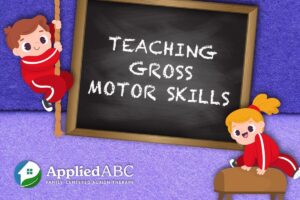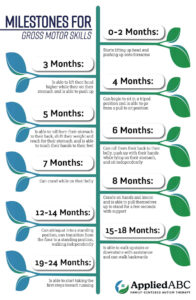
Picking up a glass to drink some water or taking a walk with friends may be something many people take for granted. We may have forgotten how much effort it took to learn these skills. Many children with autism will never be able to pick up an object by themselves or walk without assistance. For others with ASD, the learning process for motor skills may take months or even years longer than a neurotypical person.
Autism is a spectrum so the learning process can differ greatly from person to person. Through ABA therapy, though, it is possible for many children with autism spectrum disorder to learn fine and gross motor skills that they may never have mastered without the expertise of an ABA therapist. Read on to learn more about what fine and gross motor skills are and ways that your child with autism can start mastering them.
What Are Fine and Gross Motor Skills?
According to researchers studying the relationship between motor skills and language outcomes, “Motor development is often broadly divided into gross motor and fine motor skills. Gross motor skills pertain to skills involving large muscle movements, such as independent sitting, crawling, walking, or running. Fine motor skills involve use of smaller muscles, such as grasping, object manipulation, or drawing.”
There are milestones for fine and gross motor skills that parents can expect their child to reach during development. If your child is unable to reach any of these milestones, it does not necessarily mean that your child has autism. Only a healthcare professional trained to provide an
official autism diagnosis will be able to diagnose your child with autism spectrum disorder.
Milestones for Gross Motor Skills
To give you an idea about what some of the milestones are for gross motor skills, we compiled a short two-year timeline that can give you a rough estimate about how development occurs for many children. Some of these may happen sooner or slightly later.
Milestones for Fine Motor Skills
We’ve also put together a short two-year timeline that can give you a rough estimate about how fine motor skill development occurs for many children. Some of these milestones may be reached before the estimated times given below.
How Learning Fine and Gross Motor Skills Differs for Children With Autism
According to a recent study that included a large sample size, “young children with ASD have significant motor delays and the delays become more pronounced with age. They too found that between 14 and 24 months the children with ASD had significant developmental delays in terms of motor skill development and these delays broadened considerably as the children got older.”
Although this can differ on a case-by-case basis, the sooner a child can receive an autism diagnosis and begin receiving treatment the more of a chance that they will be able to learn fine and gross motor skills.
One form of treatment that has been endorsed by the CDC and the US Surgeon General, is called Applied Behavior Analysis, or ABA therapy. ABA therapy is personalized to meet your child’s exact needs by breaking down challenging life skills and goals into bite-sized
pieces. Through practice and repetition, your child can become more confident, independent, and social on their personal journey with autism.
If you want to learn more about ABA therapy, click here.
How Children With Autism Learn Fine and Gross Motors Skills Through ABA Therapy
Once a child begins ABA therapy, a Board-Certified Behavior Analyst (BCBA) will create a treatment plan that focuses on specific skills that your child will hope to learn with their Registered Behavior Technician (RBT) during therapy. If they are targeting certain fine and gross motor skills like learning to pick up a spoon or write down their name on a piece of paper, your child’s RBT may use some of these techniques to help them learn fine/gross motor skills.
-
Discrete Trial Training (DTT) – This therapy technique involves breaking down an action into small, bite-sized pieces. Whether it’s holding a pencil or drawing a straight line, DTT uses positive reinforcement as a means of incentivizing the desired behaviors.
-
Natural Environment Teaching (NET) – This technique takes place in a natural setting, such as a classroom or a store, when a more complex, less structured approach is required. This scientifically proven teaching method lets ABA practitioners use their surroundings to help children with autism understand, develop, and hone learned skills.
-
Social Skills Groups (SSGs) – These are small gatherings — led by an ABA therapist – that give children with autism an opportunity to focus on specific, personalized goals while playing team games and participating in group activities. Participating in an SSG can help them learn and watch others perform the fine or gross motor skills they may have been practicing.
These are just three of many ways that an ABA therapist may use to help your child with autism learn fine and gross motor skills. Ultimately, goal progression comes from the work that you put in at home as a parent, encourage your child for their accomplishments and be patient as they are learning.
If you’re interested in learning more about receiving ABA therapy services, visit our getting started page.
Sources Cited:
Gonzalez, S. et al. Do Gross and Fine Motor Skills Differentially Contribute to Language Outcomes? A Systematic Review.
Hasbro Children’s Hospital. Fine and Gross Motor Skills Development.
Lloyd, S. et al. Motor Skills of Toddlers With Autism Spectrum Disorders.





